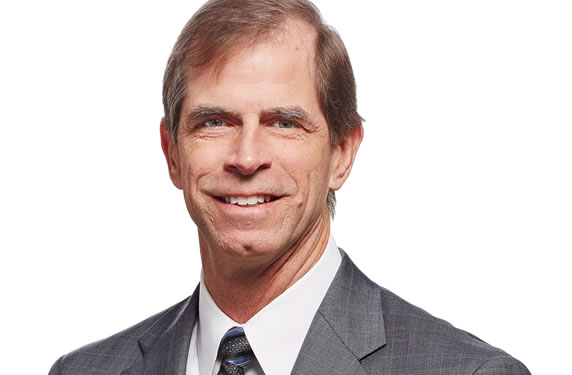You don’t often find a commercial real estate private equity investment professional who has seen the industry from every angle: engineering, design, construction, and ownership. But Rick Furches, director of development for Rubenstein Partners in Philadelphia, has done just that.
With a degree in structural engineering, experience in design, and skills in construction management, Furches is now responsible for issues related to planning, design, approval, construction, and development for Rubenstein-owned real estate and properties being considered for acquisition.
His well-rounded expertise comes in handy, whether Rubenstein’s acquisitions involve major redevelopment or not. “Old buildings, new buildings … I take a look at everything,” Furches explains. “You always want to make sure that what’s being represented as being sold is exactly what you’re buying.”
Q: How did you get started in commercial real estate?
A: Since college, I’ve been involved in the industry in some respect. I got my degree in structural engineering, and then entered the world of design for a few years. I remember thinking how curious it was to work for three or four weeks, and then have the owner come in for a meeting and tell me, “I like this, I don’t like this, let’s try this.” He would leave, and then I would work for another three or four weeks before he came back in again to review my work and explain what he liked and what he was thinking. I realized then that I wanted to do what he was doing as the owner or developer. So I made that my goal.
I then started working for a major contractor in the Philadelphia area, managing large construction projects. I now had experience on the design side and on the construction management side, but always with an eye toward the ownership side.
After a few years, I found the right opportunity with The Fox Companies, a local and regional developer based in the Philadelphia area. As senior vice president of development, I worked there for about 20 years, developing projects all over the Delaware River Valley. I’ve now been with Rubenstein Partners as director of development for the last 10 years.
Q: What are some of your biggest career accomplishments so far?
A: When I was with The Fox Companies, we developed a 900-acre mixed-use development project called Chesterbrook Corporate Center – one of the earliest large mixed-use developments in the nation. Being involved in that from the early stages all the way through was exciting. We developed over 1 million square feet of office space over a decade in that complex, and created a very nice environment that became a model for other people to emulate. Being involved in a development that you’re proud for people to occupy or visit is what I enjoy about what we do.
At Rubenstein Partners, we recently worked on a rewarding project in northern New Jersey, where there’s a lot of emphasis on adaptive reuse and being conscientious about suburban sprawl in new building and development projects. We purchased an old, outdated R&D facility that was originally built in the 1940s during World War II and expanded like a rambling farmhouse over the next 40 years. We’ve since demolished 1 million square feet of obsolete buildings, added to, and renovated one portion of this former Alcatel-Lucent campus into a 680,000-square-foot new corporate headquarters for Bayer Pharmaceuticals. We’re now in the process of adding another building to that campus: the national headquarters for MetLife Investments. The township had lost tax revenue as the property sat vacant, and that 200-acre area was almost a black hole in the middle of this New Jersey community. We revitalized it after seeing an opportunity that others maybe didn’t see.
We also currently own one of the oldest office towers in Alexandria, Virginia – 2461 Eisenhower Avenue – which is in the midst of a $45 million renovation. This 360,000-square-foot, 15-story office tower had its 1960s era precast and glass façade removed, and the entire building was gutted down to its concrete structure. To date, a new energy-efficient, environmentally sensitive curtainwall façade system with elements of glass, precast, and metal panels has been installed. We are currently finalizing the balance of the internal systems design and expect to reintroduce 2461 Eisenhower to the market as a LEED Silver building in late 2016.
Q: What do you enjoy most about your role?
A: We’re focused on the entire East Coast; we cover everything from Boston to Miami and as far west as Chicago, Nashville, and New Orleans. Any time we acquire or are looking at a property, we try to work with local architects, contractors, and other professionals in that area because they know the officials, the tenants, the marketplace, and the vendors. They’re well-equipped to help us be most effective. I’ve enjoyed working with very high-quality professionals all over the East Coast. You’re only as good as the people on your team. If you go with a large, multi-national corporation, you don’t know necessarily who you’ll get. It ultimately comes down to relationships and the people on your team. We cultivate relationships with high-quality, first-in-class operating partners, designers, and contractors in each region.
Q: Have you made a mistake that resulted in an important lesson learned?
A: I can tell you a couple of lessons learned from a potential mistake we ultimately avoided. We always buy builder’s risk insurance whenever we do a project. Through the years, I often wondered, “Why do we buy this? We keep spending all this money and we never utilize it.” But, on one project with The Fox Companies, we ended up utilizing it twice to the tune of almost $12 million.
Not only had we bought the builder’s risk insurance, but we also bought project completion and business interruption insurance from the same company. If we didn’t get this large, high-profile sports arena project done on time, the insurance company was going to have to pay proceeds because we didn’t get it opened.
We had a major flood in the building after just energizing all the main electric switchgear; all the hardware and finishes were sitting on the ground floor. Major portions of the project had been damaged or ruined. At 18 months into the project, we had to take a big step back – and we had six months to completion. If the facility did not open on time, it couldn’t hold events that had already been scheduled, which would have resulted in lost revenue. The insurance company had big losses they were viewing down the road on the project completion and business interruption policies if they didn’t get this builder’s risk claim resolved quickly. Consequently, this claim was resolved very fast and the project delivered on time.
The lesson learned was to couple your insurance carriers together when possible so that everyone’s interests are aligned, and everyone is working together and pulling in the same direction to get the project completed.
If we hadn’t had these policies from the same company, the builder’s risk claim adjuster would have come in and said, “My problem is not your project being completed on time. My problem is just finishing the work I’m supposed to do here.” They would have taken their time, set up a salvage yard, and completed a project or resolved the claim in their own time and probably would have caused us to deliver the building late. But because they had this other policy on the other end that was very likely more onerous if they didn’t meet that deadline, they worked very diligently to get us up and running as soon as possible.
The key takeaway is: Whenever possible, try to ensure that interests are aligned on as many facets of a project as possible.
Q: What advice do you have for others in your industry based upon your experiences?
A: First, there are no shortcuts, whether it’s a small or large project. Don’t assume you can skip steps along the way. You better touch all the bases or, sooner or later, it will come back to haunt you.
Second, nobody’s perfect. Don’t assume that, just because you have a contract, lease, or agreement defining all the terms very neatly, everything’s going to turn out perfectly. We’re all human; we all have flaws. There are always going to be problems, which is why you need to surround yourself with the best team possible. You can try to demand that people do their jobs to the best of their abilities, but don’t assume it means that someone will deliver perfectly every time.
Q: How have you seen the commercial real estate industry change over the years?
A: There’s been a greater emphasis on getting projects finished quicker, which makes sense. But as a result, we’re squeezing the front end of projects; the designs are suffering and it’s throwing more burden onto the contractor to figure things out in the field.
In general, I’ve seen more responsibility being shifted onto the general contractor and construction manager to resolve things in the field instead of being worked out beforehand during the design stage.
But this has had the unexpected consequence of making the owner, architect, and contractor more of a unit as opposed to three separate players. It forces the team to collaborate together and work things out before you break ground, and then again during the construction phase.
It takes us back to the 1500s and 1600s, when we had the great Renaissance in buildings in Europe. There weren’t architects or contractors, but the person who led the project was called the “master builder.” He did the design, oversaw construction, and made sure it was delivered to the owner. He was responsible for everything.
This current team effort is getting us back to the “master builder” approach: one person or team (the architect, owner, and contractor) working together as a master builder instead of working separately.



 An award winning editor, Leah spent over eight years in senior editorial positions at both BUILDINGS magazine and ARCHI-TECH magazine. Her work has been incorporated into training and educational programs around the country. She is a graduate of University of Iowa. She is Editor at Large for High Rise Facilities.
An award winning editor, Leah spent over eight years in senior editorial positions at both BUILDINGS magazine and ARCHI-TECH magazine. Her work has been incorporated into training and educational programs around the country. She is a graduate of University of Iowa. She is Editor at Large for High Rise Facilities.